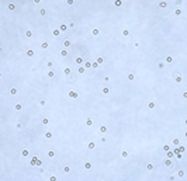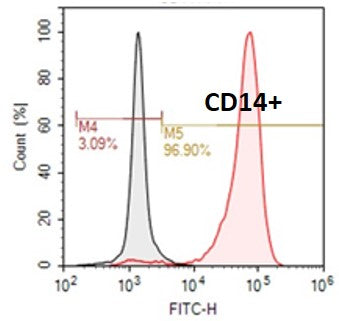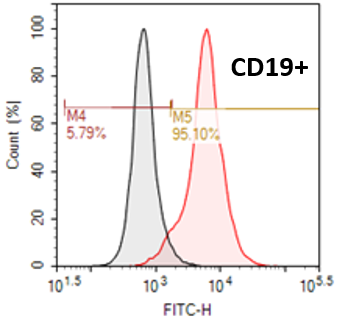Human Normal Peripheral Blood CD3+ Pan T Cells
 Most T cell lineages express surface protein CD3, which is made of invariant subchains belonging to the immunoglobulin superfamily. CD3 is a multimeric protein complex, which is composed of four distinct chains (CD3g, CD3d and two CD3e). CD3 on the cell surface associated with the T-cell antigen receptor (TCR) functions in the signaling transduction cascade that originates when a peptide - MHC ligand binds to the TCR.
Most T cell lineages express surface protein CD3, which is made of invariant subchains belonging to the immunoglobulin superfamily. CD3 is a multimeric protein complex, which is composed of four distinct chains (CD3g, CD3d and two CD3e). CD3 on the cell surface associated with the T-cell antigen receptor (TCR) functions in the signaling transduction cascade that originates when a peptide - MHC ligand binds to the TCR.
These T cells can be subdivided further into NK cells, CD8+ cytotoxic T cells and CD4+ helper T cells. T cells are used to perform research in immunology as well as oncology and infectious diseases.
Our CD3+ Pan T Cells are isolated from mononuclear cells by negative selection. All peripheral blood is collected in acid-citrate-dextrose formula A (ACDA) by leukapheresis from fully consented IRB approved donors that are tested negative for HIV, HBV and HCV.
In immunology, the CD3 (cluster of differentiation 3) T-cell co-receptor helps to activate both the cytotoxic T-Cell (CD8+ naive T cells) and also T helper cells (CD4+ naive T cells). It consists of a protein complex and is composed of four distinct chains. In mammals, the complex contains a CD3γ chain, a CD3δ chain, and two CD3ε chains. These chains associate with a molecule known as the T-cell receptor (TCR) and the ζ-chain (zeta-chain) to generate an activation signal in T lymphocytes. The TCR, ζ-chain, and CD3 molecules together constitute the TCR complex.

Figure 2. The T-cell receptor complex with TCR-α and TCR-β chains (top), ζ-chain accessory molecules (bottom) and CD3 (represented by CD3γ, CD3δ and two CD3ε). In the immunological synapse, the stimulation of TCR and CD28 by the corresponding receptors on the antigen-presenting cell (APC) trigger the activation of different signaling pathways that lead to the induction of the immune response. T cells are activated by binding of the major histocompatibility complex (MHC)/antigen complex (the yellow rhombus represents the antigen) to TCR.
Also available from 
Fisher Catalog No.:
- NC3796677 (5 million cells, Cat#: PBCD3-C5M)
Related Products:
| Catalog# | Format | Product name | Size | Price | Quantity |
|---|






